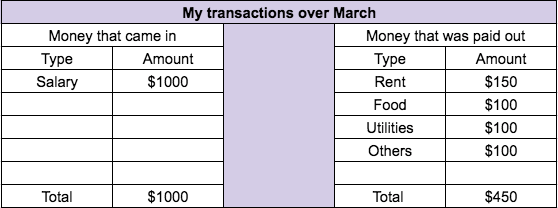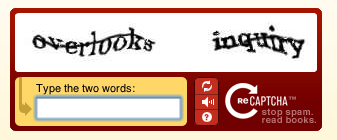So here’s a list of 10 terms within crypto that you should know. There’s no ways about this. You ought to understand this stuff.
Blockchain
I’ve spoken about this in another post. But here goes. You’ve maintained a budget ever? Don’t worry if you’ve not. Let’s say I ask you to maintain a record of your money transactions this month. By transactions I mean, any money received and any money that has gone out. So you maintain a page or an excel sheet or the likes to record this over March. It should look something like this:

Think of a digital version of this. Now scale that up to cover the entire world. That’s blockchain. Technically, a blockchain is a decentralized (not in control of any one person or entity), distributed (something like the internet, spread across the world), digital ledger (something like the excel sheet I posted above). It is essentially a chain of blocks (that’s how it gets the name). Each of these blocks consists of information on a particular transaction. So if owe you $100 and send it over via the blockchain, that block (containing information of this transaction) gets added to the chain. It stays there forever as proof.
Cryptocurrency
Now that you’ve figured out blockchain. What purposes can it serve besides maintaining records? For one it can be used to create currencies (digital money) against paper money. No longer do I have to pay you the 100$ in paper money. I pay you using a digital currency, a record of which automatically gets logged on the blockchain. Why need a separate currency you may ask when we have the dollar, euro, and the likes? Those are controlled by the government and subject to manipulation. Being decentralized, cryptocurrencies are in effect a play of demand and supply with no middleman (read government here). There are pros and cons to this. But for now, it’s enough to know that cryptocurrencies are digital currencies secured, functioning or built on the blockchain.
Bitcoin
Bitcoin was the first blockchain-based cryptocurrency. I’m presuming you understand “blockchain-based cryptocurrency” now given the first two terms in this list. So this was initially proposed as the currency of the blockchain in a research paper written by someone who goes by the pseudonym, Satoshi Nakamoto. The abstract within the paper envisions Bitcoin as a “purely peer-to-peer version of electronic cash that would allow online payments to be sent directly from one party to another without going through a
financial institution“. So, Nakamoto saw financial institutions as an unnecessary entity in transactions between you and me. And, he wanted to enable transactions without having them as the middleman. That’s where Bitcoin was proposed as a currency.
Altcoins
Since Bitcoin came into being and began seeing adoption, the concept of digital currencies grew. Bitcoin’s success got in new players within this space. Again think of the internet, personal computers, smartphones. The success of one attracts newer players. The same thing happened within cryptocurrencies. Other ones came in – Ethereum, Litecoin, Cardano, EOS. So all of these “others” – cryptocurrencies other than Bitcoin – alternatives – came to be known as “altcoins” (ALTernative COINS). Today there are thousands.
Mining
Remember the excel sheet I pasted above with my monthly expenses and income? Easy to make right? Now think of the same in the setting of a company. Not as easy, right? Suddenly you need accountants and auditors. The scales increased. There needs to be a check kept on ensuring no fraud takes place and stuff.
Same way in the world of blockchain, when I see you a $100 for example, that transaction needs to be checked (think of someone playing the role of the bank here). This is where miners come in. Miners are the accountants or auditors of the blockchain world. Without getting into complexities here,
- blockchain transactions use a certain code to verify transactions. (This code has been built into the technology and platform)
- Miners “decode the code” to verify the transaction
- In return, they get a fee for doing so (of course this process is technical, time-consuming and energy-consuming)
Proof of work
This brings us to the next term – Proof of work. You ever seen something called a CAPTCHA while logging into some website? Something like this,

That’s in a very basic form is a Proof of Work. It requires some work from your side to deter malicious uses of that platform. Go back to the earlier term (mining) and I spoke about a code that miners need to decode to ensure the veracity of a transaction.
This puzzle that miners need to solve is called the Proof of work. Once they solve this, a block is created which gets added to the chain.
If you want to delve further here, please check out this link. He’s done a brilliant job explaining this concept.
Proof of stake
So, proof of work, as we understand, involves heavy calculations in solving the puzzle while verifying a transaction. Because of this, it is an energy drainer. So as an alternative, the Proof of Stake (PoS) was invented. Since mining is expensive, we have no miners here. The miners are replaced by validators. Validators basically stake (wager or bet) a certain number of currency they have, so as to be selected to o the job. Therefore, the validator (read miner equivalent) that stakes the most amount of currency has the highest chance of being chosen as the leader and creating the next block. If a miner is caught cheating with a block, he/ she risks losing all the staked coins.
PoW and PoS can be a little complicated to wrap your head around. Quickly, here something that can help:
Let’s say there’s a kilo of gold buried in a garden. There are five people who chose to find it. No one knows where exactly it’s buried or how deep.

PoW: All five are let loose in the garden. They dig, sweat it out and struggle to find it. Almost come to blows with each other at times. Eventually, one person finds it.
PoS: (This is put in place to avoid the fights, the struggle and risks). Let’s say the kilo of gold is worth $1000. So these five miners (now let’s call them validators) will be asked to put some funds aside as a guarantee (against violence or destruction of the garden completely). Let’s say they provide funds, based on their paying capacity, as follows:
A $300
B $50
C $50
D $400
E $200
Now since D has staked the highest amount, he is given a chance to go into the garden. Dig first all by himself and try and find the gold. So there’s some order that comes in.
I wanted to cover a few more terms here but realize it’s gotten long. In a follow-up to this, I plan to cover some other concepts.

